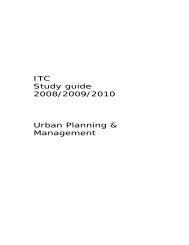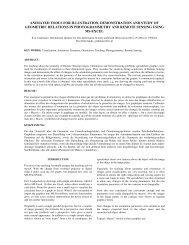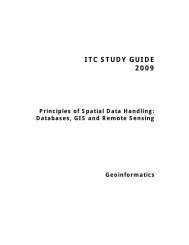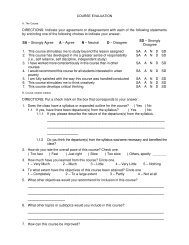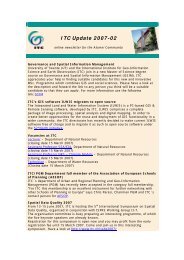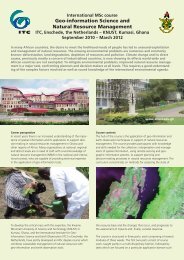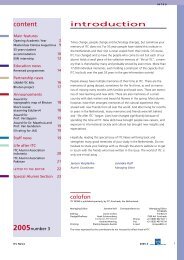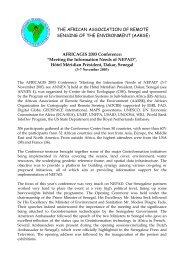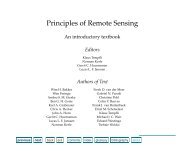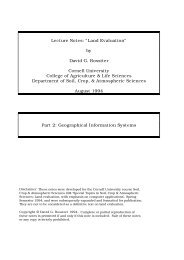Sensitivity Analysis of Soil Site Response Modelling in Seismic ... - ITC
Sensitivity Analysis of Soil Site Response Modelling in Seismic ... - ITC
Sensitivity Analysis of Soil Site Response Modelling in Seismic ... - ITC
You also want an ePaper? Increase the reach of your titles
YUMPU automatically turns print PDFs into web optimized ePapers that Google loves.
Figure 1-4 A representation <strong>of</strong> the crosshole tomography method. Left borehole consists <strong>of</strong> the transmission<br />
signals and the right one has the geophones, which receives the signals transmitted from the other<br />
borehole.<br />
Material properties should conta<strong>in</strong> shear wave velocity or shear modulus, damp<strong>in</strong>g ratio, unit weight<br />
and thickness. Water table depth is also another parameter that is needed to implement.<br />
Unit Weight<br />
Unit Weight parameter is the weight <strong>of</strong> a unit volume <strong>of</strong> soil is referred to as its unit weight. The units<br />
<strong>of</strong> unit weight will be force per unit volume, whereas the units <strong>of</strong> density are mass per unit volume.<br />
Unit weights can be calculated as follows;<br />
•<br />
•<br />
Dry Unit weight γ d =ρ d g kN/m 3<br />
Bulk Unit weight γ =ρ g kN/m 3<br />
• Saturated Unit Weight γ sat =ρ sat g kN/m 3<br />
•<br />
•<br />
Unit weight <strong>of</strong> water γ w =ρ w g kN/m 3<br />
Submerged unit weight γ =γ sat - γ w kN/m 3<br />
The gravitational acceleration “g” is generally taken as; 9.81 m/s 2 . Above calculations are <strong>in</strong> scientific<br />
<strong>in</strong>ternational units but for SHAKE2000 for unit weight pounds cubic feet is used.<br />
Shear Modulus<br />
Modulus <strong>of</strong> rigidity or shear modulus can be expla<strong>in</strong>ed us<strong>in</strong>g elastic properties <strong>of</strong> materials. The quantity<br />
µ, sometimes also called the rigidity, that is experimentally observed to relate stress and stra<strong>in</strong> accord<strong>in</strong>g<br />
to Hooke's law (Weisste<strong>in</strong>, 1999 ),<br />
[Stress]= µ[Stra<strong>in</strong>]<br />
It can also be expla<strong>in</strong>ed as, a measure <strong>of</strong> the resistance <strong>of</strong> the body to shear<strong>in</strong>g stra<strong>in</strong>s.<br />
Stress can be describes as, a force per unit area provided either by gravity or by the flow <strong>of</strong> viscous<br />
fluid. And stra<strong>in</strong> can be described as, the dimensionless parameter describ<strong>in</strong>g deformation. It can be<br />
thought <strong>of</strong> as the movement <strong>of</strong> one corner <strong>of</strong> a cubic box from its <strong>in</strong>itial position under a stress. In<br />
simple words, it is the relative change <strong>in</strong> shape and/or volume <strong>of</strong> a body.The concept <strong>of</strong> the formulas<br />
shown here are related with Elasticity <strong>in</strong> Mechanics, here the basics are given but the broader explanation<br />
is out <strong>of</strong> this research therefore it will not be expla<strong>in</strong>ed <strong>in</strong> detail. This parameter is used if shear<br />
wave velocity <strong>of</strong> the material is not known <strong>in</strong> SHAKE2000 and should have a unit <strong>of</strong> kilo pounds per<br />
feet.<br />
10<br />
<strong>Sensitivity</strong> <strong>Analysis</strong> Of <strong>Soil</strong> <strong>Site</strong> <strong>Response</strong> <strong>Modell<strong>in</strong>g</strong> In <strong>Seismic</strong> Microzonation For Lalitpur, Nepal



